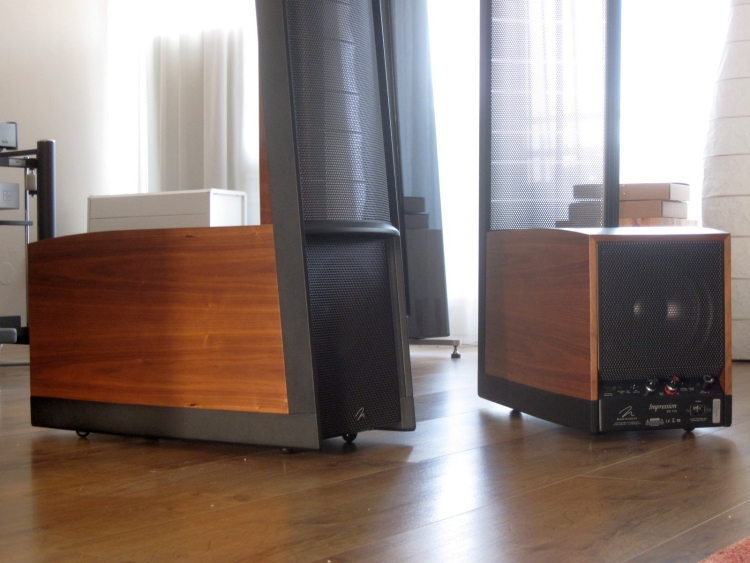
Holy Guacamole!
Review samples kindly supplied by LookenListen, distributor for the BeNeLux
Retail price in the Netherlands: €7.100 per speaker (14.200 for a stereo pair)
Holy Guacamole! Simply put in the same positions as previous dynamic speakers that I used in this room, on their standard plastic feet, with standard cables and default settings, without running in and without any tweaks I started listening, and right away the sound is breathtaking. So good in fact that they made me consider changing speakers.
I had to get that off my chest. Now for a decent introduction. Martin Logan is a manufacturer who never stops development. Even if you would not expect it based on their similar appearance from model to model, each new series also actually represents an improvement in sound quality. This is clear right from the moment that you start listening to the Impression ESL 11A.
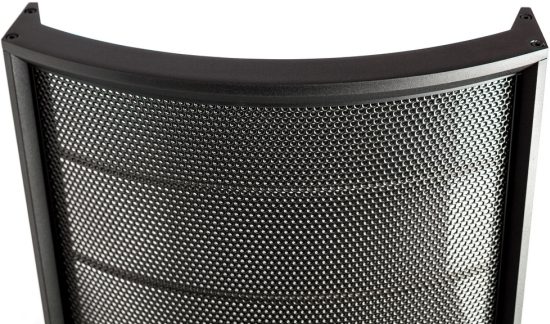
Martin Logan speakers are divided into 3 main categories: the Motion Series, Electromotion Series, and Masterpiece Series. The Motion Series marks the entry-level with highly affordable hybrid dynamic/magnetostatic speakers. My Fresco surround speakers are descendent of this series and combine splendidly with the Apogee Diva speakers. The Electromotion series includes hybrid electrostats that offer extremely high quality for the money. Within the Masterpiece Series, you will find the best electrostats that Martin Logan builds, including the model of this review. The Impression ESL 11A could be seen as the ideal middle product in this series. Beneath it is the Classic ESL 9, a more classic model, and above are two models that are similar to the 11A, but bigger and bigger still. Ultimately on top are the CLX, a full range electrostatic, and the Neolith, the most impressive hybrid electrostatic of all time.
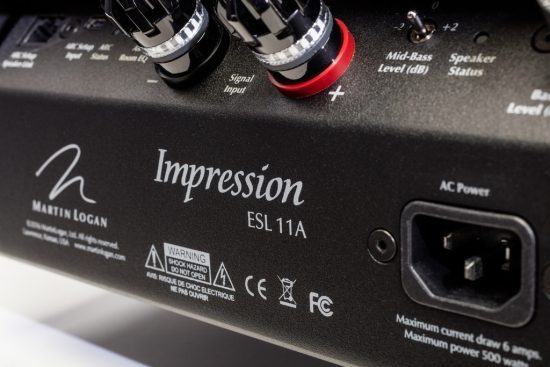
The ESL 11A’s are beautifully shaped. The sides of the frame are even narrower in width, but deeper, and thus more invisible yet stiffer than those used in past series. The woofer cabinet is beautifully finished with two options of genuine wood veneer or high gloss polished black or white paint, or at extra cost in any (metallic) color of your choice, and contains two 8 inch woofers in a PoweredForce Forward configuration.
The two woofers work in a smart phase-timed collaboration, driven by two separate 275 watts class D amplifiers. They produce not only a very deep and very powerful bass but also counteract rear wall reflections. The low-pass filter for the woofers is controlled by 24-bit Vojtko DSP, with Anthem Room Correction technology further optionally optimizing the frequency curve of the woofers.
To run Anthem Room Correction (ARC) with the Logans, you will need to purchase a PBK (MartinLogan Perfect Bass Kit) for 149 euro. The Martin Logan microphones are fully compatible with Anthem Room Correction for MartinLogan speakers. The ARC software can be freely downloaded from The Anthem website. More about this can be read further below.

The high-pass crossing over for the electrostatic panel is analog and done completely passively with a Vojtko filter using quality polypropylene capacitors and air-core coils. All electronics are nicely packaged in their own metal sections, underneath the woofer cabinet. Behind the speaker next to the controls are the latest 0703 WBT connectors, and two status LEDs. The latter I think is a big improvement compared to the blue LEDs that were previously on the front. Very nice is as well is that the bass is not only adjustable in level but that there is also a separate controller for the mid-bass which can be set in 3 steps.
At this point in the review, listening is done using the AVM Ovation A6.2 integrated amplifier supplied by Jan Legel, via Jorma Design no.3 speaker cables. The source is the Antipodes DS music server, via USB to the Bricasti M1 DAC that is connected via Siltech Paris cinch interlinks to the AVM amp. Because the Divas are set up perfectly and not so easy to move, the Logans are positioned in front of them, which also partly results in the difference in presentation between the two (Divas more sonorous and warmer, Logans more open and precise). The nice thing about the Logans’ active bass section is that it is very easy to restore balance in such cases using the rear panel controls.
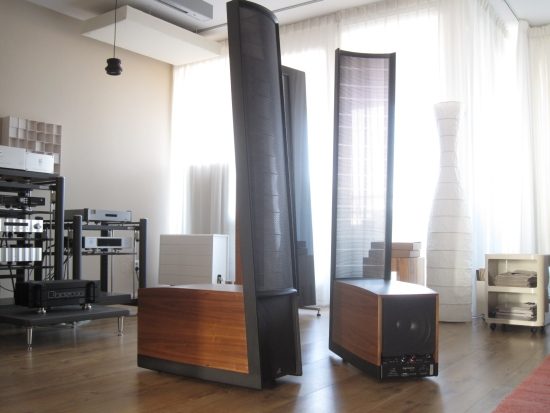
At 14,100 euros the ESL 11As are clearly in a higher class than the Ethoses that I owned not so long ago. The 11A’s however not only visually impress me more but their sound is also quite another story. Especially their bass: wow! It is so very coherent, agile and propulsive, with no booming or honking whatsoever, simply very low, pure and solid, and very convincing. The frequency range is 29-23.000Hz +/- 3dB. That’s really impressive, and you’ll hear the benefits too. Concert music has that extra almost inaudible “carrying” power down low that you also experience live, electronic music sounds breathtakingly clean and detailed from the lowest lows to the highest highs, and R&B gains a new dimension, as you’ll hear low bass lines that were simply missing before. The speakers as a whole also sound very linear and neutral. A very smooth frequency curve is, of course, a nice thing to have, but for me, PRAT and swing are more important. Fortunately, my constantly tapping foot indicates that this area is also covered perfectly.
Apogee Diva
As most readers will know, the Apogee Diva Full Range Ribbons have been used as my reference for years, alternately used with Jeff Rowland Model 6 Monos and a Bryston 3BST (with both amplifiers having their specific pros and cons). The Divas have many great aspects and are really hard to beat as a whole, or on their strong areas, but as I’ve already pointed out, after hearing the ESL 11A’s, I was really quite flabbergasted.
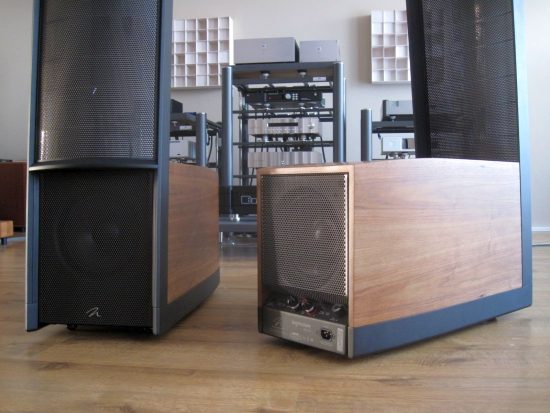
The Divas have different strong areas and their presentation is quite different from the Logans’ as well. As far as similarities go, the Divas have a comparatively large spatial presentation and also have an impressive bass, but in a very different manner. Apogee experts already know this, but for unprepared people, it is often unbelievable how much bass comes out of those panels. It is not the tightest or punchiest bass, but contrary to Magnepans, Apogee foils move a lot of air and provide very natural and non-boomy deep bass. As far as I can judge in-room, both systems produce about equal amounts of bass, but the Logans are considerably more coherent, faster and more propulsive, and much more dynamic too. Want authority? This is it! In addition, the 11A’s are better articulated, fresher and cleaner, and the mid to top coherence and delicacy are truly remarkable, better than any Apogee I have heard.
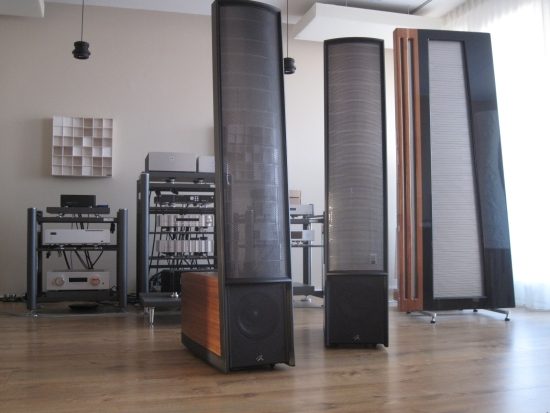
The ESL 11A’s treble is beautifully open yet airy and subtle and in refinement and air certainly a match for the Diva’s ribbons. Despite their powerful and open sound, they are never harsh, forward, or otherwise intrusive. It’s quite amazing really.
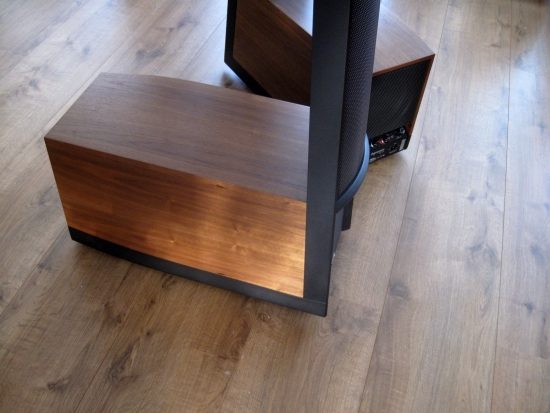
Just like with the Divas, and probably most speakers, the best focus and depth image is heard when you’re sitting smack in the middle, but thanks to the Logans’ curved foils, the entire frequency range is intact across a wide area, approximately spanning the width of a 3-person sofa. The left and right persons will still hear a linear frequency range, but not so much the spectacular imaging in the depth plane that these speakers are capable of. Although all Logans act as a line source in the vertical plane, the height of the electrostatic panel in combination with the rear tilt makes sure that treble remains relatively open even when walking around in the room.
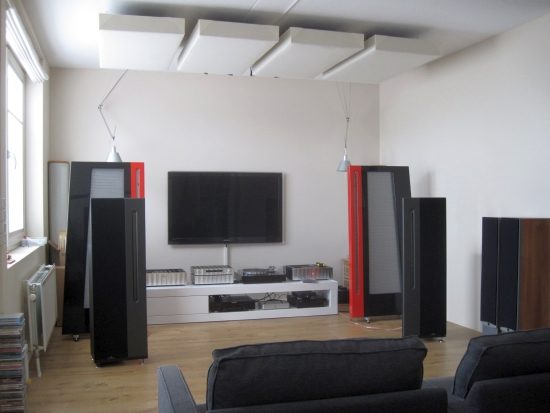
Perspective
At the moment of this review, I was in the fortunate position of having 3 different setups all connected up simultaneously across the two rooms. The AVM amp and Logans further raise this figure to 4 setups. Crazy for sure, but boy is this ever so comfortable thanks to the two Roon endpoints that are both on loan from Ohm Audio, to allow switching between setup right from the listening position. This does require some experience, however.
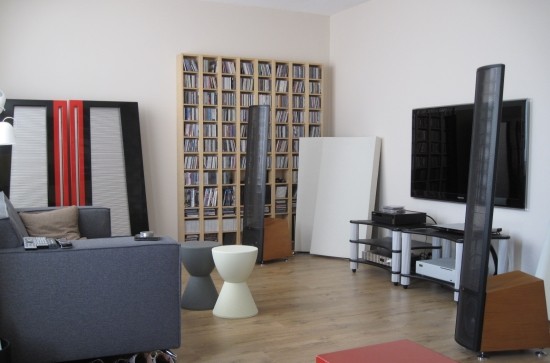
Above and below: Martin Logan Ethos in two different incarnations of the secondary listening room
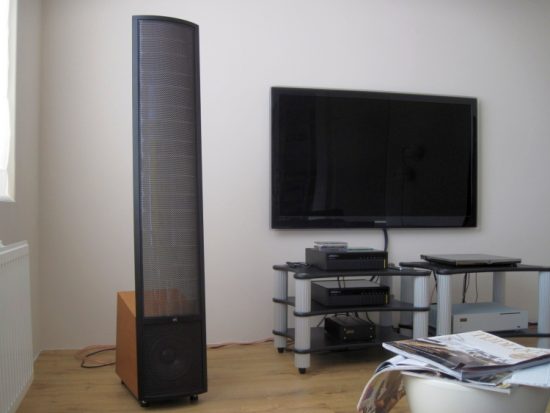
Because no two systems are equal, and a direct switch between two sets immediately exposes the differences, one has to be careful not to be distracted by these obvious differences, but be patient and get adjusted to the different presentation, and then assess the merits. The human hearing is extremely clever in compensating, and the brain already starts to create some sort of new standard for the new presentation after a few songs.
If you suddenly switch to a completely different sound without taking the time to get adjusted to it, then you may find the previous sound “better”, even if it is not. Because of this, it may often be better to insert some time between the switches, similar to how you neutralize your taste with water during a wine tasting.
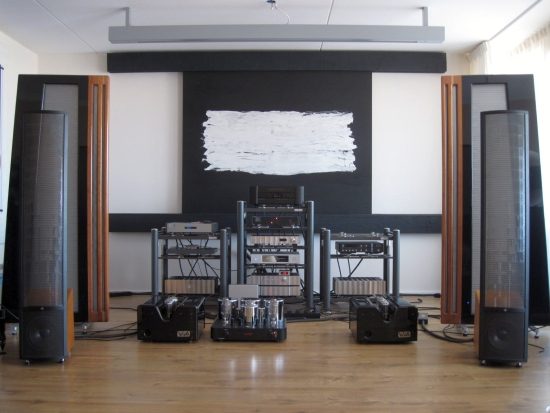
Above: Martin Logan Ethos in front of the Divas
I always switch back and forth multiple times and make sure that my hearing has adapted to the new sound before reaching a conclusion. This way I could compare the Logans with the Divas, but also with the Duetta Signatures and Centaurs, and a pair of Dali Icon 6 for good measure.
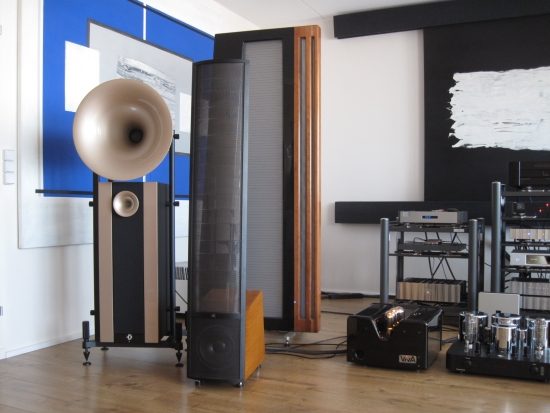
Above: Martin Logan Ethos and AvantGarde Uno, certainly a bunch of 3 very special speakers
Ethos and Impression ESL 11A
Not so long ago, the Martin Logan Ethoses had been set up in each of my then two listening rooms, and I recall their sound vividly. Although they really sounded great, and no matter how impressive their bass was especially given their small enclosures, the bass-foil coherence was clearly not at the level that I now hear with the 11A’s. The imaging of the 11A’s is not radically different from that of the Ethos, but the 11A’s really felt more at ease in my big listening room, where the Ethoses felt a bit lost as if they could not quite fill the large space so well as the smaller space of the secondary listening room. The A11’s timbre is also richer and clearly fuller than the Ethos, especially in the upper bass/lower midrange. This is not just a matter of more or better bass, but the midrange itself also sounds bigger and richer and more complete.
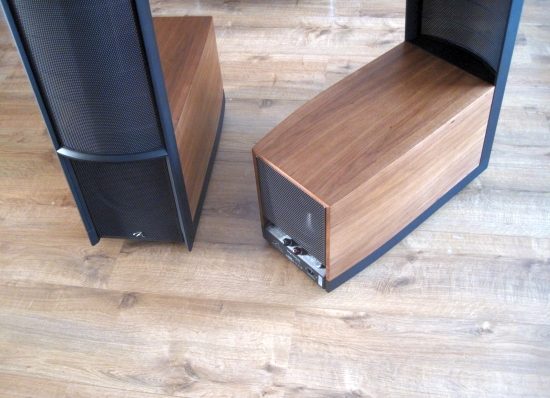
Martin Logan critics are often talking about a mismatch between bass and foil, and while a single true full-range driver naturally forms the ideal to strive for, personally I think that the coherence has always been very good with Martin Logan speakers, even a lot better than with some fully dynamic speakers. For example, the B&W 802D’s definitely sounded more disconnected from bass to midrange than did my old Martin Logan SL3‘s. The Ethos, in turn, managed to produce a deeper bass with a smaller enclosure which, in addition to being fast and accurate, was also very well matched with the foil. When well-setup, you could not hear the crossover point. In retrospect, however, that bass did have a different character than the midrange and treble coming from the foils, but with the 11A’s I do not feel that way. What’s more, the 11As not only sound better than the SL3 and Ethos but also smoother and coherent than any of the Apogees that I have currently set up. The speed and articulation in the bass keep amazing me every time. As a “Grund-ton Mensch” (bass-oriented person), this superb bass, combined with a midrange that is both immensely open and dynamic, as well as utterly grain-free and super smooth, is simply irresistible for me.
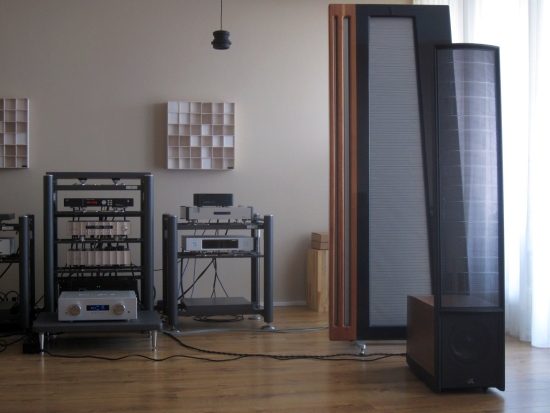
Apogee Centaur
The hybrid Apogee Centaur (Dynamic bass, ribbon MRTW) also has a surprisingly good coherence between woofer and foil, very good soundstaging, and a similarly open and airy treble, but nowhere near the bass authority and depth, nor the enormous power reserves of the Logans. Also, the Centaurs are quite neutral but do have a bit of a wooden character to them. This can sometimes enhance recordings and make them sound more acoustically convincing (wooden instrument timbres) but other times it can make one too aware of the limited size woofer cabinet as well. The Logans, by contrast, seem to have no character at all. They are simply sublimely transparent. And because the Centaur (also a line source) is not very tall, the treble falls off considerably, and quite a bit more severely than with the Logans, when standing up and walking around in the room.
In spite of their revelatory clean and transparent presentation, the ESL 11A’s never sound harsh or aggressive and they are superbly neutral. Warm recordings sound richly full and warm while clean recordings sound precisely so. Although they can sound larger than the physical size of the room that they are placed in, they don’t make a small instrument sound larger, and likewise, a bad recording is not made any nicer than it is, but importantly they also do not aggravate such recordings.
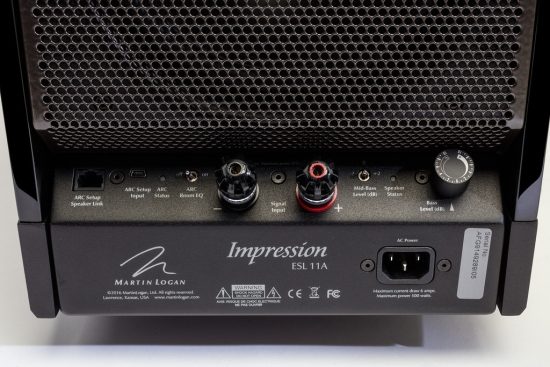
Adjustments
Up to now, the speakers have been listened to with all settings in their neutral positions, and without optimizing the speakers for position, toe-in or tilting. They sound so fantastic that I just did not feel the need to change anything. The Logans are more than a meter closer to the listening position (distance 4m) than the Divas, giving them less room-induced bass gain (let’s call these positive room modes), and therefore they sound cleaner and less voluptuous in the bass than do the Divas. The beautiful thing about the active bass section of the 11A is that they don’t only offer bass level control, but also have a separate control for the mid-bass. With the Ethos speakers and their single level control it was always tricky to find the precise right balance. Set it too low and the sound was thin, too high and the bass overshadowed the midrange, at the expense of overall coherence. With the 11A you can easily up the bass a little beyond neutral if you like it that way (I know I do): the midrange clarity is not affected quickly. In smaller rooms, the -2dB setting of the mid-bass control will undoubtedly be very useful, but in my case, the +2 setting was exactly what I needed to fill that bit of position-induced thinness, with the +1 dB setting of the bass level control making me forget about the Divas altogether. Again, and especially after making these settings: what an absolutely fantastic bass! And at this point, I did not even use Anthem Room Correction.
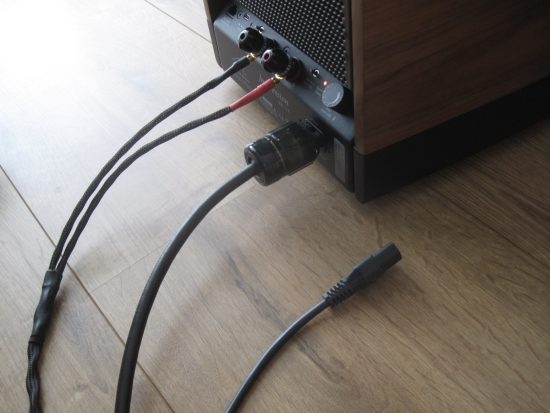
Power Cables
Then it’s time to see what the power cable’s impact on these speakers is. So far I have purposely used them with the standard cables that are included. Jan had warned me that the cables have a large influence on the sound, urging me to replace them with something better right away. And they do, but of course, I wanted to hear this for myself first.
When the standard power cables are replaced by Belden with Furutech Fi28, there is, even more, authority, already a strong feature of these speakers, but the bass now has, even more, power and body and is even more tonally and acoustically convincing. In comparison, the original cables sound quite thin but very fast. With the Belden + Furutech, the bass is now a bit less impulsive but still very cohesively connected to the midrange, and tonally certainly more beautiful. More important than the increase in bass quality is the lower midrange, which has now also gained a fuller tonality, which increases the naturalness of timbre, and thus the midbass button could be returned to its neutral (0dB) position. The soundstage focus (also a strong side of Martin Logan in general) has also increased: percussion and voices are even more clearly positioned in their own place. The treble finally, as I am used to be Furutech, is silky and airy, and friendlier than when using standard cables.
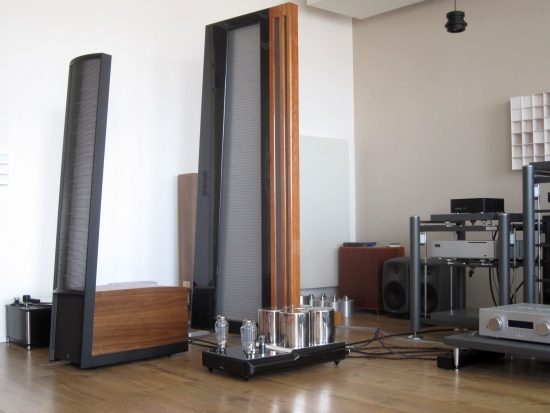
Amplifiers
Martin Logans are not hard to drive at all, and because of this, they match well with a wide range of amplifiers. It is important that it is of high quality, and because Martin Logans can play very, very loudly, it never hurts to use a nicely powerful amp. With a sensitivity of 91dB and a nominal 4 ohms, they are pretty efficient and so many tube amplifiers should also apply. Do note that the speakers have a dip to 0.6 ohms @ 20khz. While musically not relevant for the vast majority of (tube) amps out there, it seems that the VAIC Reference 520 amps lose a bit of their impulsive dynamic behavior because of this. These of course are SET designs, with no damping factor to speak of, and there are few speakers that they drive properly.
The AVM Ovation A6.2 amp that Jan delivered along with the speakers, however, matched marvelously with the ESL 11A’s: fast, powerful, transparent and very lively it may not be a “romantic” amp, but it always carries across the emotional message clearly without ever sounding aggressive.
As the Rowland model sixes were set up in the other room, I did not try them with the ESL 11A’s. Experience gathered using the Ethoses, however, suggests that they will mate beautifully too. The latter also worked very well with both the Accuphase E-260 and the Devialet 120, so those brands may also be a nice option for the ESL 11A’s.
Speaker Cables
Martin Logan speakers sound a lot cleaner and more transparent than Apogees, and even more so than the typical dynamic speaker. This is certainly spectacular to hear, but it might also take some getting used to. In this case, it might be worthwhile to experiment with other speaker cables than those that were used for the previous speakers.
I have only used the speakers with Jorma Design no.3 cables and as these worked so well on so many levels I have not carried out further experiments. The Jormas are very refined and detailed, but also very clean themselves and not very full sounding. Because the Logans are so transparent and uncolored, this may not have been the best combination, leaving me to desire some more body in the upper midrange with some music.
There are many warm-sounding cables but what you don’t want to do is use cables that get in the way of the Logans’ magnificent refinement and transparency by thickening or woolying up the sound because that is one of their most impressive aspects. I did not get around to testing this, but I have a feeling that Cardas Clear, or perhaps also the older Golden Reference, would work very well with these speakers, providing some more body and color to the midrange while letting through the resolution that the speakers are so capable with.
Other cables
The aforementioned Siltech Paris interlinks are very modest but pretty neutral performers. I like to use them because they make it easy to determine the character of connected components. In retrospect, however, I think that they were probably not fully doing the Logans justice. The silly thing is that I have many other interlinks, among which is a pair of Cardas Clear XLR‘s which I think would have worked perfectly. The thought simply did not cross my mind while reviewing because you guessed it, I was just enjoying the speakers too much.
Remember: in audio, it is always about system synergy, and finding the right match. Just like with source components and amplifiers, it is always advisable to take the extra effort to get those final, but very important, i’s dotted.
Position, Toe in, Tilting, Feet
And then we finally arrive at what usually matters most: the perfect setting up! At this time I’m already nearing the end of the review and still I do not feel the need to adjust their initial positions. Quite simply I’m just enjoying them too much! However, I must note that this position has already proved to be good for several other speakers, but this is still no guarantee.
Because I have owned Logans before, I know that they can produce even better sound staging than the 11A’s have hitherto provided. But their staging and focus is already so very good, and the rest is simply so sublime that so far I rather played more music than take the trouble to perfect the speakers. Then again, after having done this, which is done in less than 2 hours if you have some experience, it turns out to have been well worth the effort. When fully optimized, the 11As reward with a sound staging that is absolutely unrivaled: vast, wide and deep, and beautifully layered, with a very clear focus.
Other speakers have also provided a very nice center image in these quarters, and Apogees are also pretty good with depth layering, but the Logans simply are even more cohesive and precise in all dimensions. This is really very fascinating and just has to be heard.
ARC
My big listening room has been acoustically optimized thanks to the 4 big bass traps and 2 diffusion panels, which makes electronic acoustic optimization unnecessary. Nevertheless, I tried it to see what this would bring.
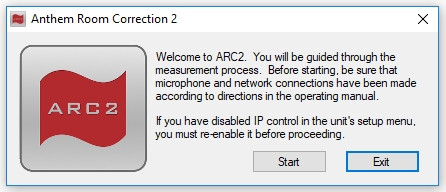
Using ARC is very easy with the optional MartinLogan Perfect Bass Kit, a measuring set consisting of a calibrated USB measuring microphone, metal tripod, and all the required cabling. The measuring microphone is connected to the USB port of a Windows PC, and one of the speakers is connected to another USB port on the same PC. The second speaker can be individually calibrated, or at the same time, by connecting it to the other speaker via UTP. Any speaker settings are overwritten during the measurement. The USB cables as part of the PBK are 375 cm long, which in my case is not long enough. By using extension cables for the mic and speaker I was able to start the measurements just fine, but when the calculated results needed to be uploaded to the speakers, the connection failed, and this could only be fixed by moving the PC closer to the speakers and removing the USB extension cables, then restarting the upload procedure.
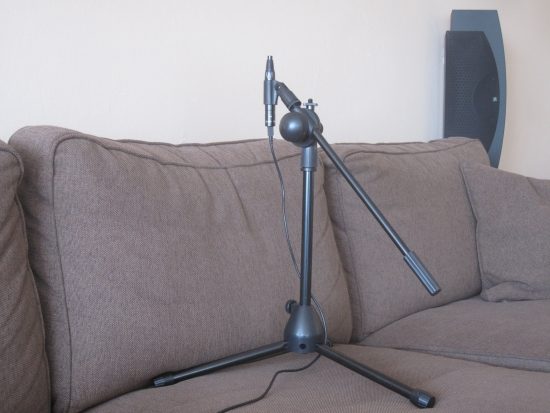
The software is free to download from the Anthem website. The measurement process is simple and painless, and after the measurements, the optimized curves are automatically uploaded to the speakers. After that, ARC can be switched on and off at all times using a button on the back of the speakers.
Prior to the ARC measurement, the speakers’ bass level was set at 1dB and the mid bass control at 0. The most obvious aberrations according to the measurement were a 6dB peak at 25hz followed by a dip of 3dB at 35hz. After correction, the average bass level is lower, making the foils sound a little isolated, but this is easy to remedy with the bass gain button. Add 2dB (ending up at a total of 3dB) and everything is in balance again. Well, I thought the speakers without ARC were brilliant and much more coherent than the Apogees, but with correction, they actually sound even more even in the bass. The beautiful thing is that this DSP does not affect the midrange and treble, as happens with standalone (external) processors. The midrange and treble are therefore untouched, but the acoustic influences of the room that in most cases are rooted in the bass, are now largely compensated. The bass drive has further increased and all the successive notes in melodic basslines have all become equally loud, making it almost as if you are listening to a high-end headphone, but much more powerful and infinitely more spacious.
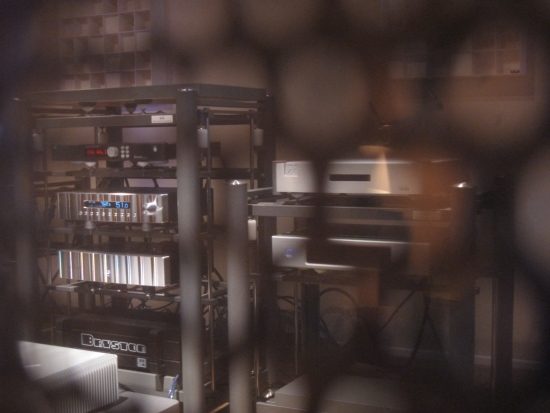
Not only transparent sounding but actually transparent!
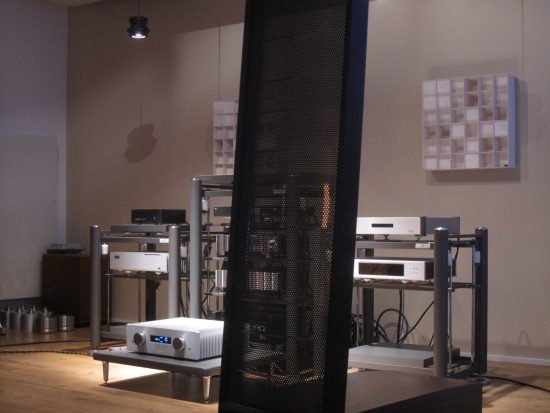
Conclusion
Martin Logan loudspeakers, in general, have always had unbelievable transparency and spatial rendering that has to be heard to be appreciated. However, with the Impression ESL 11A, the company has taken a significant step forward. This is not only the most coherent hybrid electrostatic loudspeaker yet, but they also produce the absolute best bass that I have ever heard in my listening room, period!
Their adjustability makes them suitable for the large majority of spaces, and when needed ARC is able to further correct room-induced irregularities so as to produce an almost ruler-flat bass curve. This means that they promise to perform optimally in just about any listening environment. What else can I say but exclaim: Holy Guacamole!

Read Also
Martin Logan ESL 15A
Anthem Room Correction with Martin Logan ESL15A
External Links
Manufacturer: Martin Logan
Distributor for the BeNeLux: Lookenlisten.nl
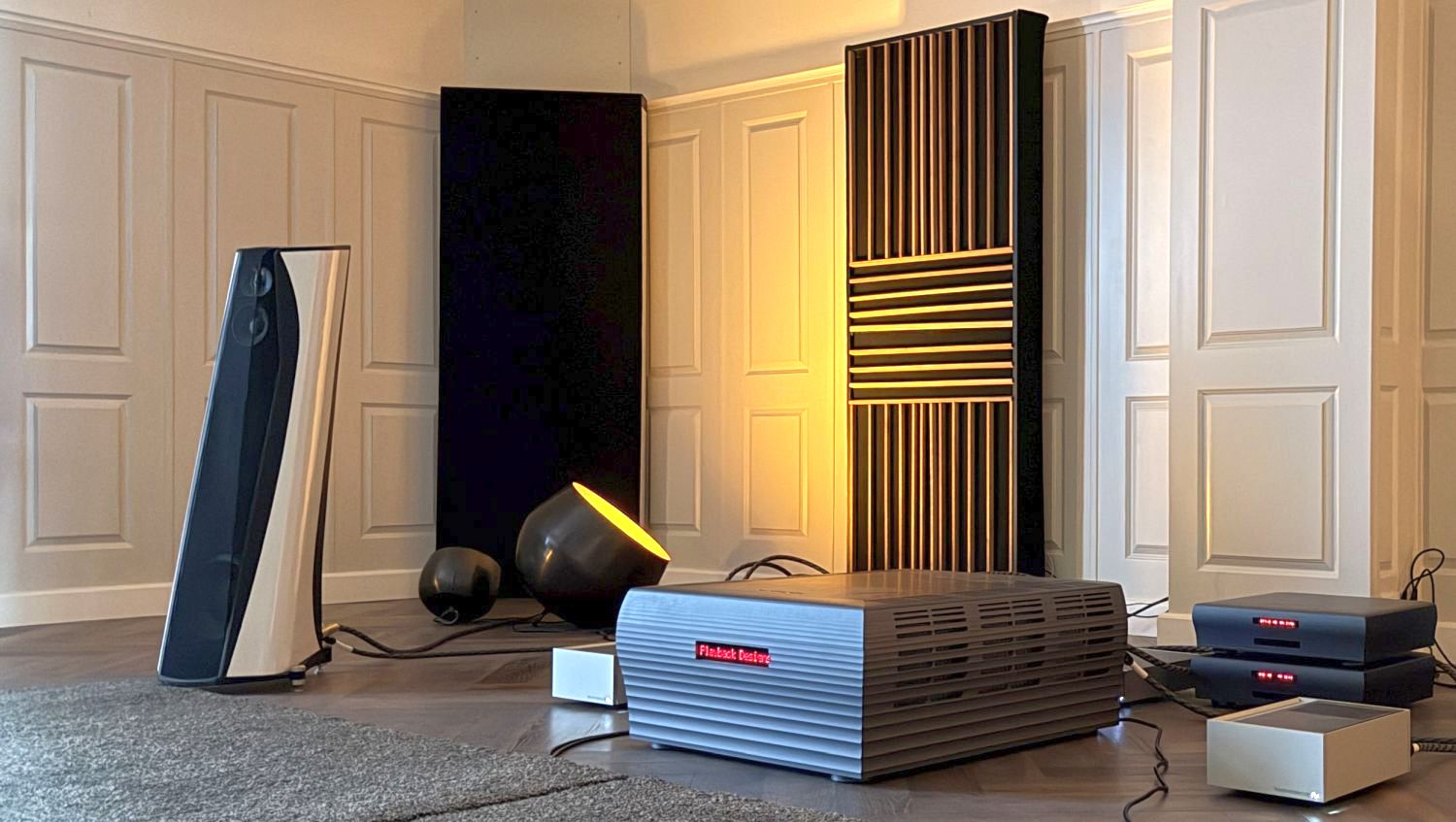
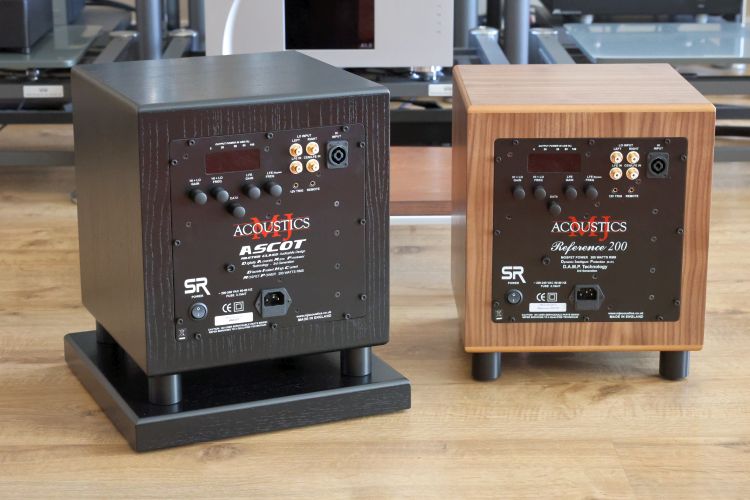
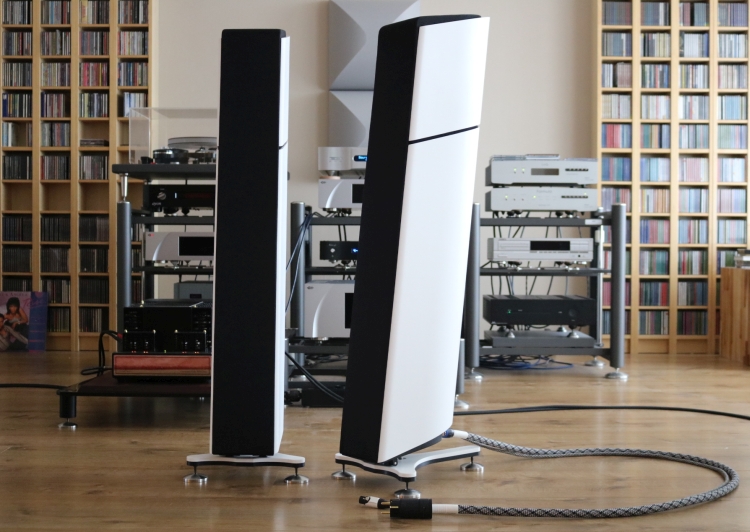
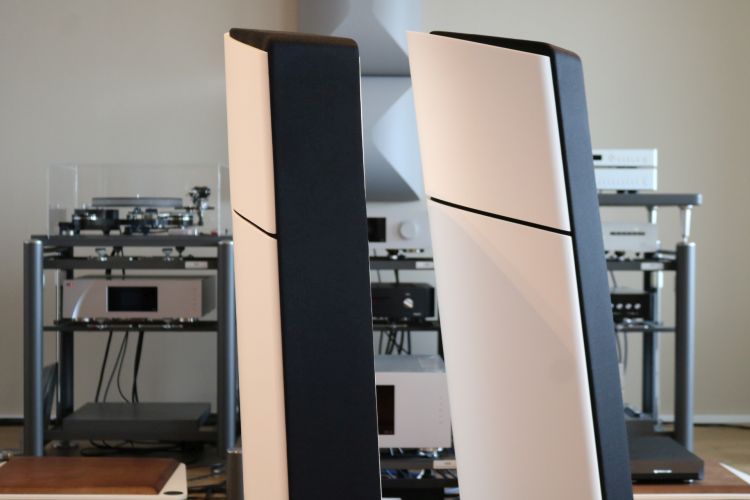
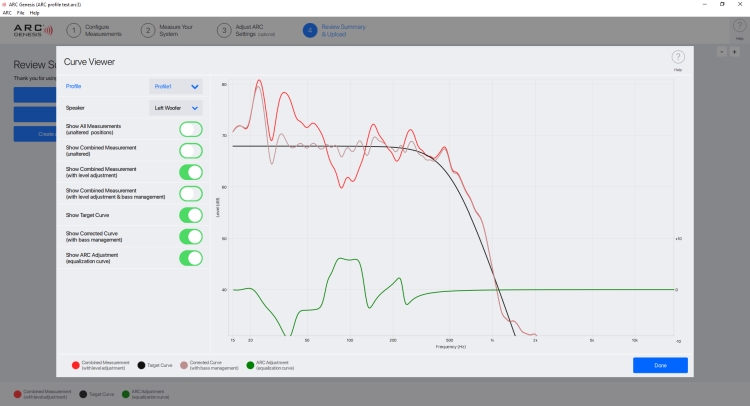
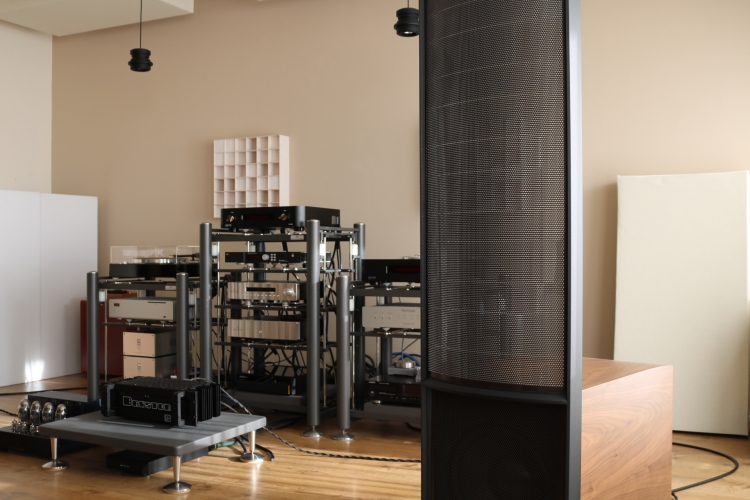
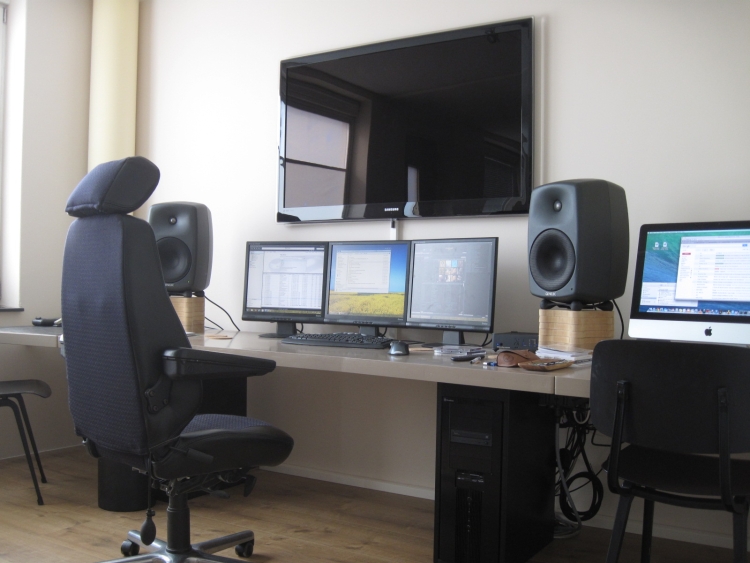
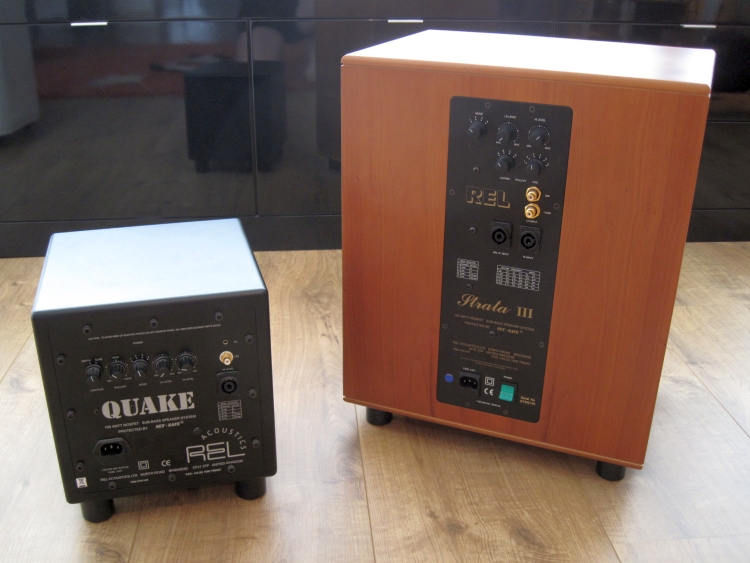
Wow.
i thought i knew a bit of your taste.
But i see mentioned here :
– Active speakers
– DSP
a real love-at-first-sight
In any case, when i read:
….focus, imaging, and depth …….
it is just envy!!!!
Hi Luca,
It’s completely logical from my viewpoint: large dipoles such as ribbons and electrostatics have always taken my fancy. I started with SL3’s, then got Magnepans and then various Apogees. Then Ethoses and now these, for review that is.
Note that the Logans are active in the bass only and likewise the DSP only affects the bass. Soundstage-wise they are mightily impressive, their low level resolution is the best I’ve heard so far and their bass is simply incredible. In fact I like them so much that I almost purchased them.
Hello!
As these speakers will be my next upgrade from ESL X, do you think Devialet Expert Pro 140 is a good match for them? I’m a lazy guy who doesn’t like to tweak/change too much…
Or is it a better option in Devialet price range?
Cristian
Hi Cristian, I’ve owned the Devialet 120 and found that it matched very well with the Apogee Duettas and the Martin Logan Ethos. Some people maintain that Devialet sounds clinical but it is worth noting that this depends heavily on the speaker match and the software version that is on the Devialet. Speakers that are too sensitive will make for an overly controlled sound and the reverse is also true: the inefficient Apogees really made the 120 blossom. I preferred a certain older version (was it 7?) (please check my Devialet review for more info and the precise version) because it sounded smoother and more fluid. The later version (was it 9?) sounded too ccontrolled and too technical for me. It is my understanding that Devialet tweaked the software to make it ever more efficient and in the process, alledgedly, they adjusted the balance between class D and class A which could be responsible for what I interpret as a cooler, more technical sound. It is also my understanding that the later Devialets such as the 140 that you contemplate to purchase do not run on the older software versions (was it 7?) meaning that you are stuck with what’s on it, or potential newer versions. So, depending on your views, either you might be mightily impressed with the transparency, expressiveness, detail and control of the 140 with the ESL11A’s or you might find the sound to be too controlled and too clinical. If you fear for the latter then you might also want to consider the Accuphase E270 and throw in the USB card. This is a very find sounding amp that subjectively has just as much power and control but a richer tonality.
Good morning again and thanks for the answer!
I came across through Xavian Perla review at the Nuprime ST-10. What a nice surprise! I’ve borrowed one for testing and I’m in love. My sound from ESL X has considerably changed: no more fatigue after 30 minutes, no more glare, no more sharp and edgy highs. Sound is a little bit darker (which I personally like), more relaxed and, perhaps as a side effect, a tad smaller stage.
My question is: is the ST-10 able to maintain the same qualities on ESL 11A? 🙂
Cristian
It is a surprising little amp, isn’t it! No worries: its character is the same when combined with the ESL11A’s and it also works perfectly with the ESL15A’s, with no restrictions whatsoever. However, those big boys do really deserve a more upscale amp. Halfway through reviewing the latter, the CH Precision electronics were delivered and they did further improve on the humble ST-10 on many accounts, but, of course, at a price. What did not change was the impression of power or dynamics: the ST-10 is certainly not lacking in those areas.
Thanks!
My last speaker upgrade will be ESL11, for at least 5 years. I can’t afford and really need the wonderful CH Precision equipment and I really believe they deserve better speakers like Chroma Audio or Wilson or ESL15. 🙂
The million dollar question: upgrade now to ST10 new monoblocks or save for Evolution One monoblocks? 🙂 Perhaps they are too much for ESL 11. 🙂
Between you and me: I like the ST10 more than the Evo’s, even though the latter are more linear, have better resolution, and more fluid treble. Now, I have not auditioned the ST10 monos and I don’t know what more they bring over a single ST10 but if it’s mostly about power then you certainly don’t need that with the ESL11’s, or any Logans, for that matter.
in the photo i saw an ayon amp.i have the triton 3 and i m interested for the esl 11a martin logans.have you tried them together?because i guess there will be treble “roll-off”.any answer is accepted and highly appriciated.thanks.
I’ve not heard the Triton but every tube amp that I tried with Logans (including the KT-150 Spirit III that is in the picture) resulted in a slower sound with more or less rolled-off treble. The Viva SET amps also do not apply. However, the Triton has double the amount of tubes and given that lots of tubes worked better when I tried Prima Luna HP monos with a friends’ Martin Logan Spires, you might give it a shot. The sound of tubes and Logans can be magical in the midrange. Just not lightning fast in the bass or very airy in the treble.
thank you very much for your immediacy.i read your articles with very interest.so in the case(wich is more realistic)of treble roll-off,with your expirience can i do any “trick”to lighten the uppers say other tubes than the kt 120 that my triton has??? or anithing else … thanks for your time ,i appriciate your answer or any thouhgts
When the treble dulls as a result of impedance mismatches there is no point in trying to counter this with tweaks. Either the tube amp’s design copes with the speakers’ load or it doesn’t. Other tubes may make a difference but ultimately the amplifier’s power supply and output transformers (and the design of these) are responsible for the success. The Spirit is not ideal with Logans. Alas, I have no Triton available for a test so if you want to be certain I would suggest to take your Triton (I know it’s heavy…) to a shop and check how it sounds with Logans. Who knows… two of my friends were happy with the Prima Luna / Logan pairing and did not mind the rounding off and dulling in the treble. You won’t know how you will feel until you have tried it.
well… ayon triton3 and martin logans …are now a happy twin and the sound is realy realy magical out of this solar system… thank you Christiaan for the advices and as you sayd a little treble dulling or rounding not matters as the overall resault is …wowww heaven on earth. thank you again.you made me A happy audio listener.
Glad to hear it, Mourat!
Dear Christiann,
I been seeing the Magico S1 MKII on your system (also one of you favorite) for a while but you didn’t review them. I am planning to change my speaker and the S1 is few of the Magico speakers I can afford. Unfortunately, I don’t have any dealer around therefore, I cannot listen to them. Do you are planning to do a review of them? Why you like this speaker so much? Other speaker on my radar is the Martin Logan ESL 11A (I can afford the bigger sisters 13A or 15A). I haven’t lived with electrostatic speakers and something that concern me is: dynamic. How you compare this speaker, in term of dynamic and impact, to a regular speaker as Wilson WP8 (very dynamic) or another good dynamic speaker like the Magico S1? I know that you are like me, need good bass, dynamic and impact so you are also the best person to ask because you been living with different type of speakers.
Hi Carlos, indeed, the S1 mkII’s are a permanent part of my system and they function alongside the Logans as I switch back and forth between them. They were a private purchase and not a review request and since I always have multiple requested reviews waiting to be done, I have not come around to reviewing them. On the other hand, I figured that so much has already been written about the S1’s that an addition from my end is not needed.
In many ways, the S1 mkII’s, and other S-series Magico’s as well, share similarities with the Martin Logan ESL15A’s. Both are revealing, transparent, articulate and refined. The Logans do sound wider and taller and have significantly deeper bass and of course, they have superb coherency throughout most of their frequency range. Even people who considered earlier Logans to lack coherence, especially in the transition between bass and foil, have commented that they perform extremely well. Ultimately, though, the S1’s are even more coherent and also slightly more articulate. Amazingly, the treble is as refined as I have heard it and easily a match for ribbons or indeed Logans.
Now, Wilsons are a breed apart. They sound very “live” and have lots of impact. Whether that’s entirely neutral or natural is open to interpretation but I will say than they have qualities that remind of live performances. The WP8’s extremely impactful sound makes them appear to be very dynamic but unless you have the perfect room ( which I don’t), it will be hard to get these speakers to sound linear.
The ESL15A’s are just as dynamic as the Magicos and while they are arguably not quite as impactful as the Wilsons, they are both more transparent and realistic and also plenty dynamic for me. Also, the Logans have considerably better bass than the Wilsons. It’s deeper, more articulate and more even-handed. Between 11A and 15A I will definitely recommend the latter but I realize that they are twice as expensive. If you read the review you’ll know what differentiates them and that tonality/timbre is a large part of this. If you can live with a less convincing tonality then the 11A’s will otherwise do a lot that the 15A’s do.
Hello Christiann,
Thank you very much for you answer!
Hi Christiaan
I just had an interesting experience with my 11A. For the last 2 years I have mainly concentrated on improving the associated equipment (power cables, electrical grounding, power amplifier, vibration feet on electrical equipment etc.).
Until yesterday I have used the hard plastic feet (with metal thread). Then I decided to try the spikes delivered with the speakers. When I dismounted the plastic feet I noticed that some of them were not fully tightened.
Then I mounted the spikes and tightened the ring around them. The sound was not to my liking. The low frequency level was significantly reduced (adding 2 dB on the 50 Hz knob was not enough). The bass was lean (lacking body) and the resolution was not improved (it was actually very good originally with the plastic feet).
Then I remounted the plastic feet – this time I tightened the feet fully. The bass level was now overwhelming and at the same time everything was somewhat muddy. Not good either.
Then I remembered that some of the feet were not tightened last time I used the plastic feet. Next move was to untighten all the plastic feet (1/2 revolution). Now I had exactly the bass level and resolution I was looking for.
The explanation could be that the thread on the feet act as hard metal springs.